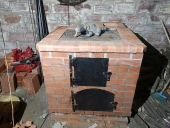

 14
14







For all your Montana Masonry Heater parts (also known as) Rocket Mass heater parts.
Visit me at
dragontechrmh.com Once you go brick you will never go back!
 7
7




Visit Redhawk's soil series: https://permies.com/wiki/redhawk-soil
How permies.com works: https://permies.com/wiki/34193/permies-works-links-threads




 7
7




For all your Montana Masonry Heater parts (also known as) Rocket Mass heater parts.
Visit me at
dragontechrmh.com Once you go brick you will never go back!
 7
7




thomas rubino wrote:
It is very dusty and soaking in water will not do much for you.
Wear a dust mask, please.
 3
3




Yes, this is why I was hoping to find a less nasty and dangerous way to deal with it. The only side grinders we have (and hubby has a collection of at least 3) are physically too large for my small hands to hold safely. I was reading the description for the BB about making a round wood mallet and how if the handle was the correct size, the thumb and finger tips should overlap a little. Similar is true of many other tools, and probably 80% of typical "built for guys" tools leave me short by an inch or sometimes more. I have a great appreciation for my fingers, eyes, lungs and other miscellaneous body parts - no taking dangerous chances for me!thomas rubino wrote: The best tool to clean up cement mortar from bricks is by using a side grinder with a masonry blade.
It's a nasty dangerous job.
Visit Redhawk's soil series: https://permies.com/wiki/redhawk-soil
How permies.com works: https://permies.com/wiki/34193/permies-works-links-threads
 8
8





 3
3




Proudly presenting RocketMassHeaters.com
A good starting point to all RMH research
How Permies.com works




 4
4




For all your Montana Masonry Heater parts (also known as) Rocket Mass heater parts.
Visit me at
dragontechrmh.com Once you go brick you will never go back!

|
Danger, 10,000 volts, very electric .... tiny ad:
The new purple deck of permaculture playing cards
https://www.kickstarter.com/projects/paulwheaton/garden-cards
|





